On August 11, 2011, Newsweek ran a photograph of Congresswoman, GOP presidential candidate, and tea party darling Michele Bachmann that ignited a media firestorm. The image taken on assignment by Chris Buck earned her the nickname, “Crazy Eyes” and marked a turning point as she went from leading candidate for the Republican presidential nomination to eventually abandoning the race in 6th place. Newsweek Editor-in-Chief Tina Brown defended the image choice and headline “the Queen of Rage” as merely portraying intensity, but many felt it was unnecessarily unflattering and sexist. In May of 2013, under investigation for ethics violations, Michele Bachmann announced she would not seek re-election in 2014.
The image also marked a turning point for Chris Buck as he had spent the previous year campaigning photo editors to assign him serious political work and this breakthrough image sent him on a path shooting more and more A-List covers in the years to come.
On November 11, 2011, I interviewed Chris about the cover and he was refreshingly candid about how it all went down. Unfortunately, the controversy had just simmered down and Newsweek was afraid to reignite it again, so we shelved the interview. Luckily, Chris has a new retrospective book out titled Uneasy (https://www.chrisbuckuneasy.com/buy-now) and this image is included so we can now tell the story behind the Michele Bachmann cover. I think you’ll find it just as relevant today.
— aPE
Rob Haggart: I want to start with Newsweek calling you to shoot a politician for the cover. That’s not something that probably happens very often with you, is it?
Chris Buck: Let’s go back to the 2008 presidential election, which I felt was such a special time, because the electorate was ignited in a way that I’ve never seen in the years I’d lived in the US. I was upset about having not gotten any of those jobs. So I decided to do whatever I could, to try to get that work for the 2012 cycle.
Rob: What did you do to try and get that work?
Chris: I put up a section on my website of political portraits. Then I made an e-mail newsletter addressing that question specifically. I featured my shoot with William F. Buckley Jr. from 2004 and had the portrait of him plus some funny out-takes. Then I contacted a number of clients more directly who I knew commissioned political shoots, like GQ, New York Magazine, and ultimately Newsweek.
Rob: It worked…
Chris: I have now shot three politicians in this election cycle for different magazines. It’s all very, very last minute. I’m basically given the heads-up a few days ahead and then I just sit around waiting for the phone call where they’re like, “Go to the airport now!” And I rush off to the airport.
Rob: And that’s because of both the approval process and the scheduling?
Chris: There’s no approval process.
Rob: They don’t have people who approve photographers?
Chris: Not that I know of. I would imagine that it could come up as a First Amendment issue if politicians were appearing to pointedly dictate terms to the press.
Rob: It’s not the same as with a celebrity then? I guess I just assumed it was. Ok, how did the assignment go down?
Chris: Newsweek contacted me, the photo editor emailed me saying, “Would you be available for this?” and he said, “It will be either Sunday or Monday, or on the weekend, we’re not sure.” My schedule was open enough. I said, “Yes, just let me know.”
I put the assistant on hold, got together the equipment I needed and just waited. Then, at the last second it was, “Go to Washington. No, no, go to Iowa. No. Go to Washington. No, no. Wait. Wait. Go to Iowa.” In the end I went to Iowa. We were actually in Iowa for a day with the campaign and then went to Washington the next day, which is where the portraits were made. The scheduling was quite chaotic.
Rob: Why do you think Newsweek hired you to shoot Michele Bachmann? Did they want something besides the traditional power portrait for the cover?
Chris: I’m not going to go into detail about my conversations with Newsweek but I think that it’s reasonable to assume that they hired me for what I do. My guess is that they wanted something a little bit more human and vulnerable.
Rob: They said, “Do your thing.”
Chris: We had a more detailed conversation than that because it is a cover. But, yes, they did say something along those lines at some point. Of course I know since it’s a cover I need to get a variety of shots. I feel a professional obligation that I give them some choices, partly, even to surprise me. Maybe it would be something I wouldn’t think of as my first choice and maybe that would be the most interesting thing. You never know.
Rob: Take me to the shoot. You’re in D.C. now.
Chris: Her campaign team were staying at the Willard Hotel; I met up with Ms. Bachmann and her people in their room. They were pushing for me to shoot there but I didn’t want to, I didn’t like the idea that the space I was going to shoot in was also going to be the suite of rooms where they are spending the day doing their business. It just made me uncomfortable. So, I looked around with the hotel staff and found another space to shoot and rented it.
Rob: How much time are they giving you to do the pictures?
Chris: We were told we’d have a half an hour.
Rob: OK, that’s good.
Chris: I didn’t realize how little time politicians often give, but it turns out that wasn’t bad. With Rahm Emanuel for Bloomberg Businessweek, we followed him around for a day, and they were trying to give us 60 seconds at a time for portraits. And I was like, “That just won’t do”. And after three long conversations, they got me a five-minute block, which they considered very generous.
Rob: Wow, OK.
Chris: So half an hour seemed kind of reasonable. If the subject is cooperative and you’ve got time to prepare ahead of time, it’s totally workable.
We had different setups in this suite of rooms. The back room was a small conference room, so we moved the conference table over, and set up the blue backdrop and some lighting. I closed the drapes so I could see what my model lights were doing. It was now a semi-dark mini photo studio.
The candidate came in a little bit late and then we waited a few minutes for the makeup artist. I went over to chat with her and she was really distracted, barely acknowledging that I was standing there. I was kind of surprised, because at the rally she was very engaged with people. And even when I saw her earlier that day, she was relaxed and happy to chat.
Rob: Did you get a sense at all that she didn’t trust you, or didn’t trust Newsweek, that she thought they had an agenda behind what they were doing?
Chris: I didn’t really know what to make of it. I just thought that she had something on her mind, and that once we stepped into the other room that she’d be engaged and it would be all good. But that’s not what happened.
It’s very important that I have a meaningful or even non-meaningful conversation with a subject as we’re going into a shoot. It’s not necessarily that I want my subjects to be super-relaxed, but there is some basic level of decorum. We’re moving into this space and we’re going to work together on this. A portrait is collaboration, and it’s laying the groundwork for that. In doing my reading ahead of time I try to pick up on little details about them and their stories, so that they know that I’ve done my homework, and I’m genuinely immersed in what’s going on. I think it shows in the work too.
So we go in the room, I have her in the frame, and she is very stiff. I said, “I’d like you to relax, and maybe even if you want to gesture a little bit, we can even talk so you can be more relaxed. I want something more animated with more life.” And she said something like, “I’m not going to do that. I’m not going to look foolish for you. I’m not going to gesture in some way that you’re going to capture that’s going to make me look foolish or awkward.”
Rob: [laughs] Holy crap.
Chris: And she said “I’m not going to be portrayed this way by the left-wing media. I’m not going to let the left-wing media frame me in some way that is going to be damaging to me.” I’m paraphrasing, but it was along those lines.
I was shocked, because one, it’s amazing for someone just to speak their mind so directly, but two, we had really just begun. And I was asking for something pretty standard, you know? Not to say that she has to do everything I say, but there are other ways to deflect or refigure something without directly accusing me and my client of trying to disparage her.
She also started talking about how when Obama was running. “He was always portrayed so favorably, and that’s the kind of treatment I want.” I was just… I mean, I didn’t know how to respond to this. And she started talking about specific Time Magazine covers that she thought were unflattering. She mentioned one of Laura Bush. I had never seen this picture, but she described it as a black-and-white picture of the first lady where every pore and line is showing.
And she asks, “that’s not how this lighting is, right? That’s not this kind of lighting?” And I said, “Well, we’ll show you or your representatives a frame so you can see how the lighting looks.” So we did a few frames so we could show her one that might look good.
Rob: So you showed them a frame to try and get her to relax.
Chris: Yes, and basically what I said to her was, look, Newsweek wants a really interesting picture, and you want a picture where you look great. And I kind of did this gesture of two circles in the air. And I said, you know, Newsweek wants this — and then I added one with my other hand — and I said there’s this other circle, and here’s where they overlap – like a quarter of each circle kind of overlaps in the middle. “Let’s find this sweet spot in the middle where you can feel confident about the way you’re portrayed, and they’re going to have a really great, interesting picture. Let’s aim for that.
And she agreed. But as we tried to move towards something I realized that, basically she agreed in theory, her attitude was already set. She was already upset and defensive. One of the things I found surprising about the whole thing that it wasn’t one of her staff who was saying, “We’re hoping we can do something like this with the candidate. Can we start that way at least, and see where we go?” That’s the kind of conversation that usually happens with a handler.
Rob: There are no handlers involved in this?
Chris: Well, there were handlers there, but surprisingly it was the candidate who was fighting her own battle.
Rob: So, you’re four minutes in, the clock is ticking down and you’re arguing with Michele Bachmann. She said, “I’m not giving you anything.” And you’re trying to tell her, “Let’s try and meet in the middle,” and she’s still refusing. So when does this picture happen?
Chris: I’m shooting and talking, it’s just a photographer’s instinct, you don’t stop shooting, at least not entirely. Of course, part of my thinking is “I’ve got to get something.”
Rob: And snap, you took the picture. Amazing. So she basically came in super defensive and said “I’m not going to give you anything,” and as she was saying that the picture that you made is the one…?
Chris: I’m not 100% sure, because I’m shooting as we’re talking. But looking at it, clearly she has either just finished talking or she is about to talk.
Rob: Incredible. Then what?
At a certain point her people are like, “Look, she needs to get back on to the Hill to do a vote. We need to leave in 10 minutes.” I’ve learned to be stubborn about protecting the time I’ve been promised because people will happily take that away from you. I said, “Look, you’re not ready to do this. You should leave. Go do your vote. Go do whatever obligations you have. And I hope you can come back later, maybe in an hour and a half, two hours or whatever, and we can do this right. Think about how you might want to do this in a way that we can both be happy.”
Rob: Wow. So you sent her away because she’s not giving you what you need.
Chris: My feeling is it’s much better to come in positive but cautious than to come in negative and defensive. No one looks good when they’re saying, “I don’t trust you.”
Rob: OK, so take me through the second session. What happened?
Chris: I’ve worked out some locations that her handler felt would help the candidate relax. I was wary about shooting outside because it gives us less control, and it sucks up time, but he felt that she’d be more relaxed in a real-world environment. He said that the room with the blue background, because it was small and dark, spooked her.
So that’s what we did first when she first came back, and clearly they had spoken with her and she was much more relaxed. Plus, she had gotten some of her duties out of the way and her schedule was less pressed. Some of the pictures from this next section are much more relaxed, and she looks great.
We shot there a bit, but I wasn’t really liking what I was getting. I was feeling like, for both my client and for myself, that these were looking like PR pictures.
Rob: Right. They’re not cover pictures.
Chris: I still needed to get something that was a great portrait for Newsweek and hopefully point towards something really interesting as a photographer for me. So, we went to this semi-rooftop of the building, and we did some more outdoor shots there. She was a little bit more relaxed but her hair wasn’t looking so great. She had already had a long day and she’s a little distracted now, and some of these pictures don’t have the same kind of focus as earlier. Then we went down to the oval room, and we shot maybe a dozen frames and that was it. But it was really a shame, if they’d given us another 20 minutes; I think we could have found that sweet spot that would have been a great Newsweek picture as well as something that she would have felt more comfortable with.
Rob: So when you’re doing your edit and you see this picture, are you thinking, “Yeah, that’s a Chris Buck shot”?
Chris: I turned in 21 images and I think we did five different set-ups, so I handed in a mix from two frames to five frames from each scenario. I had three favorites. The one that became the cover, the one in that Oval Room that became an inside picture, and then the one I showed as an outtake on my blog.
By the way, one thing I’ll mention to you, is that I did something I almost never do, which is when the shoot was done I let the handler who was there hang around and look over our shoulders a little bit while we were looking at the material. I wanted him to know that what I had said before was genuine, that I really was trying to find a place that both the candidate and the magazine could be happy.
Rob: So he saw all the pictures?
Chris: We didn’t sit and specifically walk him through the pictures because the last thing I want is for him to say something like, “That picture is something I don’t like. I’d rather you not use it.” But he knew perfectly well he wasn’t there to influence the edit.
Rob: So Newsweek orders the high res…
Chris: They order four high res: the praying shot, the one that became the cover, the oval room picture, and then one at the rally.
Rob: Did you know that this shot was going to be the cover?
Chris: No, when he gave me the image order, he said, “We might come back and ask for more.” In fact, on Friday night, he came back and asked for two more. And one of them was one of the rooftop shots and one of them was another shot from the blue background set-up.
I was a little worried because those shots were more conventional and less interesting to me, I was really pleased with their initial edit and I told them so. A lot of people assume that the edit was entirely Newsweek’s doing and ultimately what ran was their choices, but I know if I include something in my edit, it could be used. I stand by my edit.
Rob: Did you have any idea of the controversy that would come after running this picture on the cover?
Chris: I did have some idea, but the scale of it was larger than I expected. They released the cover to the media on Sunday night, so I Googled, “Newsweek Bachmann cover” and already it was on “Gawker” or a site like that. They sent out a pretty high res pdf of the cover. So sites were blowing it up really big, just on the face, and it was already being talked about as being like a controversial cover. Let’s just say, I didn’t sleep very well that night.
Rob: [laughs] You didn’t?
Chris: No.
Rob: Really? You were distressed?
Chris: I have mixed feelings about it. On one hand, I was pleased they picked a really interesting picture. But at the same time, I’m a human; ultimately I would love it if people liked the pictures I take of them. It’s not my first thought, it’s not my first obligation, but I’m human. I prefer they like it, than not like it. And I understood that she was unlikely to be happy with this choice.
Rob: Then you must battle with that constantly because I can’t imagine ever hiring Chris Buck and not trying to get some kind of moment like that.
Chris: I’m not saying that it’s not fair and that it’s not reasonable. I included it in the edit not only because I think it’s interesting but because on some level I feel that it captures something of who she is, something of her character and something of her campaign. It was one of the most intense and aggressive photo shoots that I’ve ever experienced in my career. So in a way, she helped make this portrait happen. The edit reflects the environment in the room; it conveys the intensity of the session.
Rob: And that’s what makes it an amazing story, but also understand that doing that is what makes you Chris Buck, what makes you a unique photographer. I can name a dozen photographers that will shoot a heroic portrait no matter what happens in the room and so it’s just how you approach photography. It’s who you are. It’s also what makes you an interesting choice, for Newsweek and any other magazine shooting politicians.
Chris: Thanks. I find it surprising that the media is quite happy to write about politicians as being flawed and yet when doing portraits sittings they seem hesitant to go down that line. They kind of fall into the convention of doing the power portrait instead of doing something that might be a little more challenging.
Rob: And, as far as your body of work goes, without the controversy that this cover created does it stand up on its own with the other pictures that you’ve made?
Chris: Oh, absolutely. One of the things I really like about this is that the two pictures I was best known for before this were the one with Steve Martin with the bread hands and the Citibank ad where the dog has fake teeth, so this being my best-known picture is something I’m much more comfortable with. It shows a little awkwardness.
People ascribe an anti-Republican or anti-Bachmann thing to me because of the impact it had in the culture, but it’s not how I feel about it. As a portrait, I stand by it. I don’t champion the right or the left; it’s not the point of this. The point was, as a photographer, to do good work for my client, to make interesting work for the public, and also to reflect, from a subjective viewpoint, what she might be about.
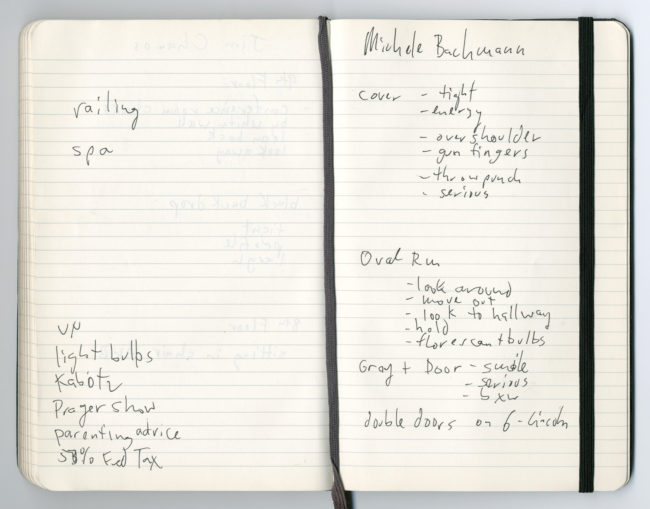
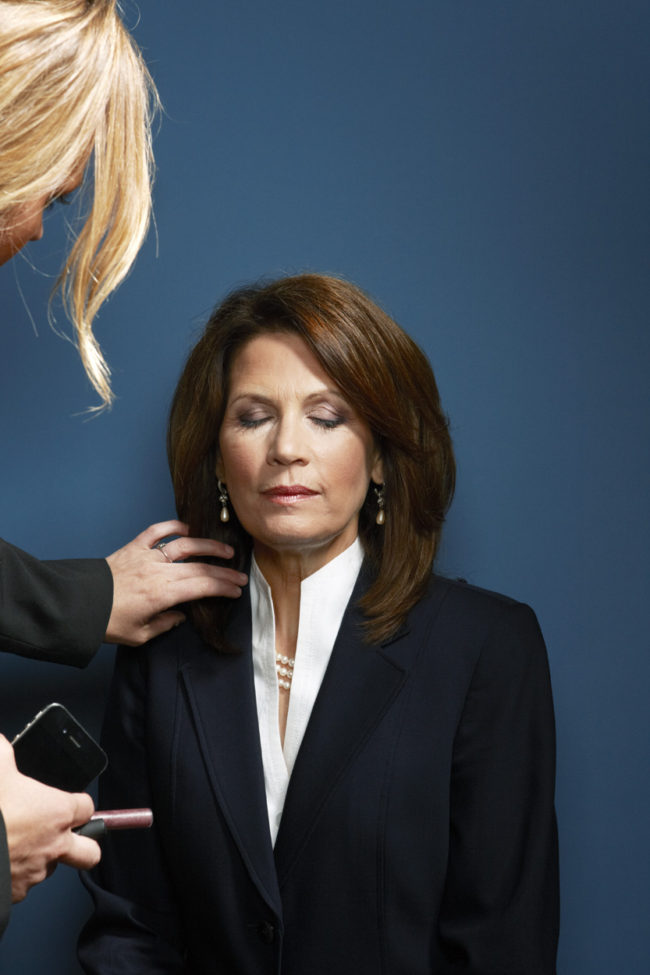
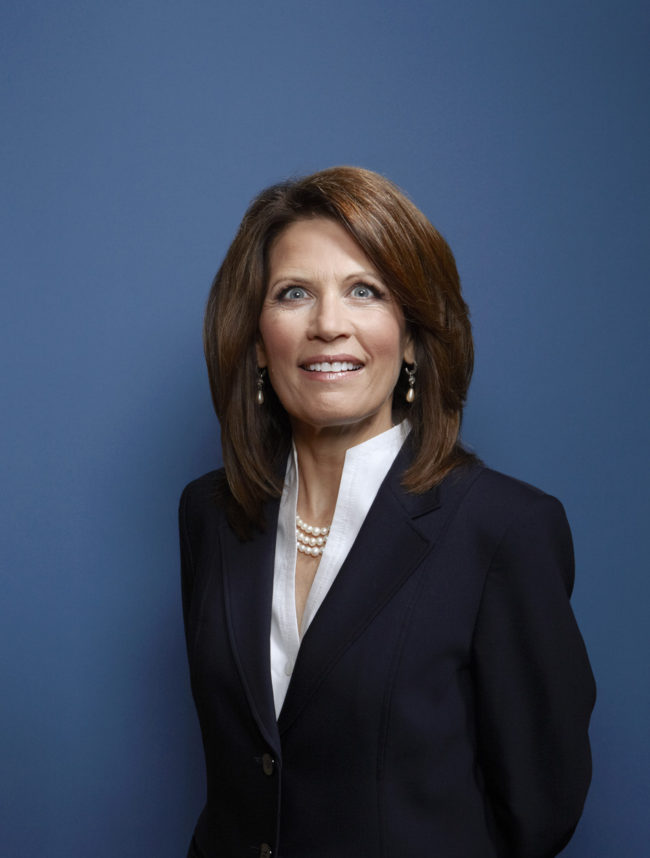
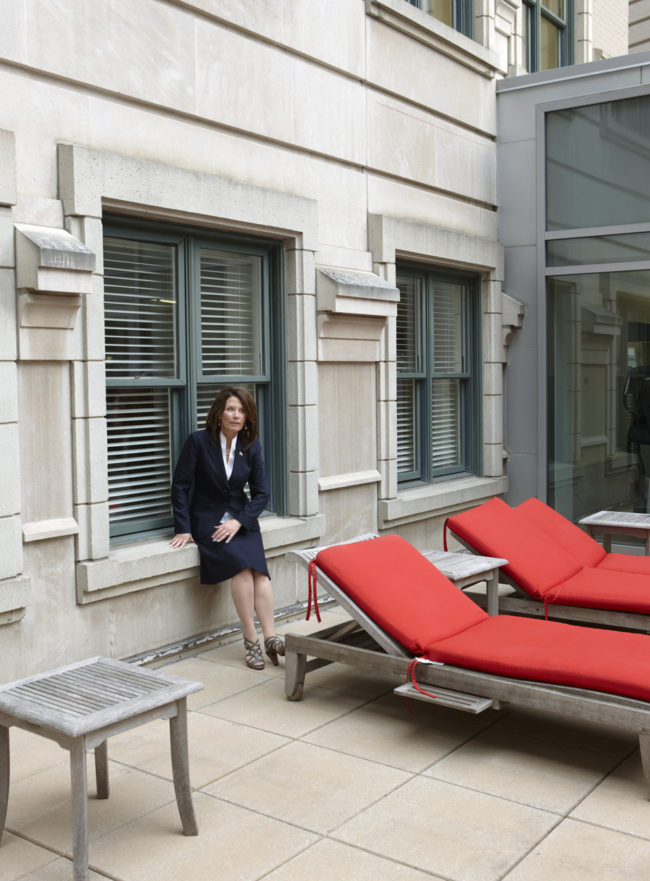
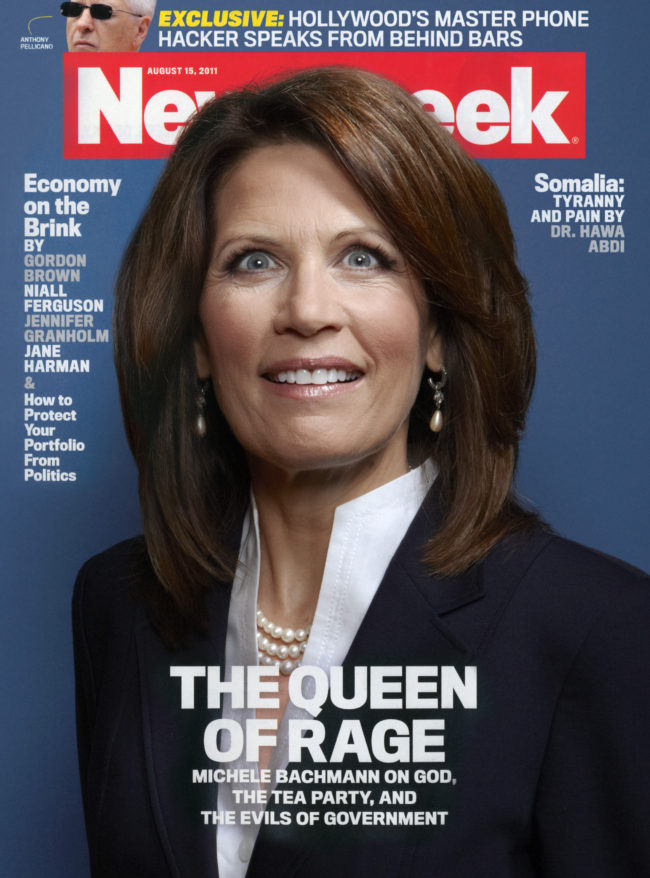
6 Comments
What an AMAZING story! Thanks so much for sharing.
Chris Buck rules, great interview.
Great interview. Thanks for posting!
This was one of the most fascinating interviews I’ve seen in a long time – great work!
I’m glad it wasn’t me. I got hired to shoot portraits of a few political people at one pint and they were all a little too enthused with the people they imagined themselves to be. Ms. Bachmann seems be the same.
My assignments sounded just like his did, as editorial had no idea of where I would be going until a few hours before I had to be on location. At another time I got assigned to do the shot, only to find that editorial had hired two of us to shoot portraits and only decided in editing which one to go with although we both got paid. I thought that was the news business?
I find th hard part of political portraits is to be in the room with somebody I do not respect and having to create a strong image of somebody who may be total nut is very difficult.
[…] • The amazing story of how Chris Buck captured the Michele Bachmann “Crazy Eyes” portr… […]
Comments are closed for this article!